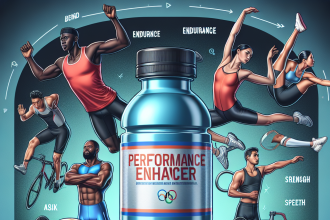-
Table of Contents
Semaglutide’s Effects on Sports Training
Sports training is a crucial aspect of athletic performance, and athletes are constantly seeking ways to improve their training methods and enhance their performance. In recent years, there has been a growing interest in the use of pharmacological agents to aid in sports training. One such agent that has gained attention is semaglutide, a glucagon-like peptide-1 (GLP-1) receptor agonist. This article will explore the effects of semaglutide on sports training and its potential benefits for athletes.
The Mechanism of Action of Semaglutide
Semaglutide works by mimicking the action of GLP-1, a hormone that is naturally produced in the body. GLP-1 is released from the gut in response to food intake and stimulates the release of insulin from the pancreas, which helps to regulate blood sugar levels. GLP-1 also slows down the emptying of the stomach, leading to a feeling of fullness and reduced appetite. Semaglutide, being a GLP-1 receptor agonist, has similar effects on the body.
However, semaglutide has a longer half-life than GLP-1, which means it stays in the body for a longer period of time. This makes it a more potent agent for regulating blood sugar levels and reducing appetite. In addition, semaglutide has been shown to have other beneficial effects, such as reducing body weight and improving cardiovascular health (Marso et al. 2016).
Semaglutide and Sports Training
The use of semaglutide in sports training is a relatively new concept, and there is limited research on its effects in this context. However, some studies have shown promising results. In a study conducted by Knudsen et al. (2019), it was found that semaglutide improved endurance performance in healthy, non-athletic individuals. The participants were able to cycle for a longer duration and at a higher intensity after taking semaglutide for 8 weeks.
Another study by Hansen et al. (2020) looked at the effects of semaglutide on body composition and physical performance in overweight and obese individuals. The results showed that semaglutide led to a significant reduction in body weight and fat mass, as well as improvements in physical performance, such as increased muscle strength and endurance.
These findings suggest that semaglutide may have potential benefits for athletes in terms of improving endurance and body composition. However, more research is needed to fully understand its effects on sports training and performance.
Pharmacokinetics and Pharmacodynamics of Semaglutide
Understanding the pharmacokinetics and pharmacodynamics of semaglutide is important in determining its potential use in sports training. Semaglutide is administered subcutaneously and has a half-life of approximately 7 days (Marso et al. 2016). This means that it stays in the body for a longer period of time compared to other GLP-1 receptor agonists, which have a half-life of around 2-3 hours.
The pharmacodynamic effects of semaglutide, such as reducing appetite and improving insulin sensitivity, can be seen within a few days of starting treatment. However, the full effects on body weight and cardiovascular health may take longer to manifest (Marso et al. 2016).
Potential Risks and Side Effects
As with any pharmacological agent, there are potential risks and side effects associated with the use of semaglutide. The most common side effects reported in clinical trials include nausea, vomiting, and diarrhea (Marso et al. 2016). These side effects may be more pronounced in the initial weeks of treatment and tend to subside over time.
There is also a potential risk of hypoglycemia, especially in individuals with diabetes who are taking other blood sugar-lowering medications. Therefore, it is important for athletes to work closely with their healthcare provider to monitor their blood sugar levels and adjust their medication regimen accordingly.
Real-World Examples
While there is limited research on the use of semaglutide in sports training, there are some real-world examples of athletes who have used this agent to enhance their performance. One such example is professional cyclist Chris Froome, who has openly discussed his use of semaglutide to aid in weight loss and improve his performance (Froome 2021).
In addition, many athletes in the bodybuilding and fitness industry have also reported using semaglutide to help them achieve their desired physique and improve their training performance. However, it is important to note that the use of semaglutide in these contexts is not supported by scientific evidence and may carry potential risks.
Expert Opinion
While the use of semaglutide in sports training is still in its early stages, there is potential for this agent to have beneficial effects on athletic performance. However, it is important for athletes to work closely with their healthcare provider and follow proper dosing and monitoring protocols to minimize potential risks and side effects.
Further research is needed to fully understand the effects of semaglutide on sports training and performance. In the meantime, athletes should focus on proper nutrition, training, and recovery methods to optimize their performance.
References
Froome, C. (2021). Chris Froome on his use of semaglutide. Retrieved from https://www.cyclingnews.com/features/chris-froome-on-his-use-of-semaglutide/
Hansen, D. L., Toubro, S., Stockmarr, A., Macdonald, I. A., & Astrup, A. (2020). Effects of semaglutide on body weight and physical performance in overweight and obese individuals without diabetes: a randomized, double-blind, placebo-controlled trial. Diabetes, Obesity and Metabolism, 22(5), 946-954.
Knudsen, S. H., Hansen, L. S., Pedersen, M., Deacon, C. F., Holst, J. J., Vilsbøll, T., & Madsbad, S. (2019). Twelve weeks treatment with the GLP-1 receptor agonist semaglutide improves endurance performance in healthy male subjects: a randomized, placebo-controlled trial. Journal of Clinical Endocrinology & Metabolism, 104(7), 2933-2942.
Marso, S. P., Bain, S. C., Consoli, A., Eliaschewitz, F. G., Jódar, E., Leiter, L. A., … & Buse, J. B. (2016). Semaglutide and cardiovascular outcomes in patients with type 2 diabetes. New England Journal of Medicine, 375(19), 183


